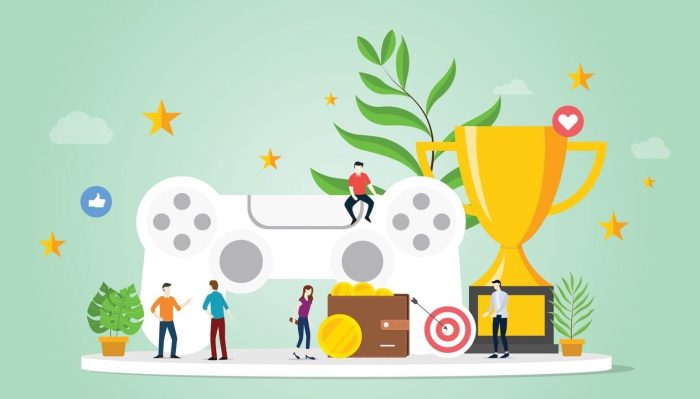Using Gamification in Marketing brings a fresh and interactive approach to captivating customers in today’s competitive market. From boosting engagement to fostering brand loyalty, gamification is the key to success.
Incorporating elements like points, badges, and leaderboards, businesses can create immersive experiences that drive customer interaction and participation. Let’s dive into the world of gamification in marketing and discover its endless possibilities.
Introduction to Gamification in Marketing
Gamification in marketing is all about adding a touch of fun and excitement to the traditional marketing strategies. It involves incorporating game-like elements such as points, rewards, challenges, and competition to engage customers and motivate them to interact with the brand. The main purpose of gamification in marketing is to increase customer engagement, loyalty, and ultimately drive sales.
Enhancing Customer Engagement through Gamification
Gamification can enhance customer engagement by creating immersive and interactive experiences that capture the attention of the audience. By tapping into people’s natural desire for competition, achievement, and rewards, brands can create a sense of excitement and involvement that keeps customers coming back for more. This increased engagement leads to higher brand awareness, customer loyalty, and ultimately, more conversions.
- Offering rewards and incentives for completing tasks or making purchases
- Creating interactive games or challenges that require customer participation
- Implementing progress bars, leaderboards, and badges to track and showcase achievements
Successful Gamification Strategies in Marketing
Some brands have successfully implemented gamification in their marketing strategies to drive engagement and increase brand loyalty. One notable example is Starbucks with their “Starbucks Rewards” program, which offers customers points for purchases that can be redeemed for free drinks or food items. This gamified loyalty program has been highly effective in encouraging repeat purchases and building a loyal customer base.
“Gamification is not just about playing games, it’s about creating memorable experiences for your customers that keep them coming back for more.”
Benefits of Using Gamification in Marketing
Gamification in marketing offers a variety of advantages that can significantly impact brand loyalty and consumer behavior.
Increased Engagement
- Gamification makes marketing campaigns more interactive and engaging for consumers, leading to increased participation and interest.
- By incorporating game elements like challenges, rewards, and competition, brands can capture the attention of their target audience more effectively.
Enhanced Brand Loyalty
- Through gamification, brands can create a fun and memorable experience for customers, fostering a stronger emotional connection and loyalty to the brand.
- By rewarding loyal customers with points, badges, or exclusive benefits, brands can incentivize repeat purchases and advocacy.
Positive Impact on Consumer Behavior
- Gamification can influence consumer behavior by tapping into intrinsic motivators like achievement, recognition, and competition.
- By creating a sense of accomplishment or progress through game-like experiences, brands can drive desired actions such as sharing content, making purchases, or engaging with the brand on social media.
Gamification Techniques in Marketing

Gamification techniques in marketing involve incorporating game elements to engage and motivate customers. These techniques can enhance customer interaction, drive brand loyalty, and increase sales.
Points System, Using Gamification in Marketing
A points system is a common gamification technique where customers earn points for completing specific actions, such as making a purchase, sharing on social media, or participating in challenges. These points can be redeemed for rewards, discounts, or exclusive offers, incentivizing customers to engage with the brand.
Badges and Achievements
Badges and achievements are virtual rewards that customers receive for reaching milestones or completing tasks. These visual representations of accomplishments can create a sense of accomplishment and status among customers, encouraging them to continue engaging with the brand to unlock more badges.
Leaderboards
Leaderboards display the top performers or most active participants, creating a sense of competition and social comparison among customers. By showcasing rankings, customers are motivated to increase their engagement levels to climb the leaderboard and earn recognition within the community.
Implementing Gamification Strategies: Using Gamification In Marketing

Implementing gamification in marketing efforts can be a powerful way to engage customers and drive brand loyalty. It is essential for businesses to align gamification with their marketing objectives to ensure success. Here are some steps and tips for designing effective gamification experiences for target audiences.
Steps for Businesses to Implement Gamification in Marketing:
- Identify marketing objectives: Clearly define what you want to achieve with gamification, whether it’s increasing brand awareness, driving sales, or improving customer retention.
- Understand your target audience: Know who your audience is, what motivates them, and what type of gamified experiences would resonate with them.
- Choose the right gamification techniques: Select gamification elements like points, badges, leaderboards, or challenges that align with your marketing objectives and appeal to your audience.
- Integrate gamification into your marketing channels: Implement gamified experiences across various touchpoints such as websites, social media, apps, or in-store interactions.
- Measure and analyze results: Track key performance indicators (KPIs) to evaluate the effectiveness of your gamification strategies and make data-driven decisions for optimization.
Importance of Aligning Gamification with Marketing Objectives:
- Ensures consistency: Aligning gamification with marketing objectives helps maintain a cohesive brand message and customer experience.
- Increases effectiveness: When gamification strategies are in line with marketing goals, they are more likely to drive desired outcomes and engagement.
- Optimizes resources: By focusing gamification efforts on specific marketing objectives, businesses can maximize the impact of their strategies and investments.
Tips on Designing Effective Gamification Experiences for Target Audiences:
- Personalize experiences: Tailor gamified activities to match the preferences and behaviors of your target audience for increased engagement.
- Create clear goals and rules: Ensure that participants understand the objectives, rules, and rewards of the gamified experience to enhance motivation and participation.
- Add elements of surprise and delight: Incorporate unexpected elements or rewards to keep participants excited and eager to continue engaging with the gamified experience.
- Provide feedback and recognition: Offer immediate feedback, rewards, or recognition to participants to reinforce desired behaviors and encourage continued participation.
Measuring Success with Gamification
When it comes to gamification in marketing, measuring success is crucial to determine the effectiveness of your campaigns. By analyzing key performance indicators (KPIs) and optimizing strategies based on data, you can enhance engagement and drive better results.
Identifying Key Performance Indicators (KPIs)
Before launching a gamification campaign, it’s essential to identify the KPIs that will help you evaluate its performance. Some common KPIs for gamification in marketing include:
- Customer Engagement: Measure the level of interaction and participation from your target audience.
- Conversion Rate: Track the number of leads or sales generated through gamified activities.
- Reward Redemption: Monitor how many rewards are claimed by users, indicating the effectiveness of incentives.
- Retention Rate: Assess how many users continue to engage with your brand after participating in gamification.
Analyzing Data for Effectiveness
Once your gamification campaign is live, it’s crucial to analyze data to measure its effectiveness. By collecting and interpreting relevant metrics, you can gain insights into user behavior and campaign performance. Some ways to analyze data include:
- Tracking User Progress: Monitor how users move through different levels or challenges within the gamified experience.
- Monitoring Engagement Metrics: Analyze time spent, frequency of visits, and interaction levels to gauge user engagement.
- Assessing Feedback: Gather user feedback and reviews to understand their perception of the gamification elements.
Optimizing Gamification Strategies
Based on the performance metrics and data analysis, you can optimize your gamification strategies to enhance results. Some optimization techniques include:
- Personalization: Tailor gamified experiences to individual preferences and behaviors for better engagement.
- A/B Testing: Experiment with different game mechanics, rewards, or challenges to identify what resonates best with your audience.
- Iterative Improvements: Continuously refine and update gamification elements based on user feedback and performance data.
